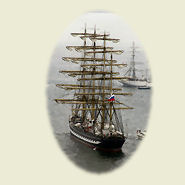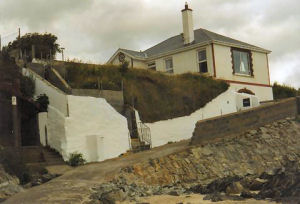Heaving Cane 
A heaving cane was about 15 inches in length, with a blob of lead to weight it at one end, and a leather becket, to which a line was attached, at the other end. It could be thrown about 20 to 25 yards, to get a line to a vessel aground close inshore. At drill a reward of 2/6d. was given to the man making the longest throw.
1851. Many of the Coastguard stations had gardens for the use of the men, but some may have been a little more ambitious (and energetic).
Lieutenant Pritchard RN has been appointed to the command of the Coast Guard service of this district, vacant by the death of Lieutenant Hamilton. We understand he has ordered all the men who held farms to surrender them at once; and certainly, if there is any necessity for a Coast Guard, it ought to be engaged sufficiently in the duties of the service. We are glad to learn that Mr. Hamilton, eldest son of the late Lieutenant Hamilton, is about to be appointed to the Lieutenancy in the Revenue Police. (Sligo Journal) (1)
The Storm November 1901.
The storm which swept over Dublin Bay was one of the fiercest experienced in living memory and it is confidently assured that nothing to equal it in violence has been witnessed by the inhabitants of Kingstown for the last 50 years.
The gale blew from the NE and all the ships in Dublin Bay suffered the effects of its violence. The Revenue cutter ‘Flora’ which has been stationed at Kingstown, was like a plaything at the mercy of the waves, and before the storm was many hours old she was dashed upon the rocks near the Coastguard station and in a short time became a total wreck. She carried a crew of ten and they were all saved by lifelines which were cast to them from the shore. (2)
| Link Removed | | Link Removed | | Link Removed | | Link Removed | | Link Removed |

Wit and Wisdom of Ireland
"It's not raining, it's a soft day" Unknown |
Tall Ships 
| | |
|
Dear Friend, Welcome to the September edition of "The Coastguard Cutter". Although they worked long and arduous hours the Coastguards seemed to have hours which they dedicated to other pursuits. Gardening was one of their major hobbies but they had other ways in using their spare time. Enjoy,
Tony.
| A Wonderful paved area at Kilmore Quay Coastguard Station.

Old Boathouse, Kilmore Quay
During the Napoleonic Wars French Naval prisoners passed their spare time in making ship models from pieces of bone left over from their dinner. The sailors in the Polar Regions chasing whales and sea-lions used tusks from which to carve decorative hunting scenes. Our Coastguards at Kilmore, in 1899, thought of building a Sundial / Zodiac mosaic floor beside their station and looked for materials. They found egg sized black and white round stones which were ideal for their project. During their daily patrol a man will patrol to the limit of the area of the station. This is where they located the desired stones. Unfortunately this throve of stones was six miles from the station. These men were not daunted by the task, and having deep pockets in their overcoats they collected stones in each pocket before returning to their station. How many journeys were necessary is not known, but their floor in all its glory is still in existence over a hundred years later. Some of the damaged parts are being repaired by Mr. John Power, a noted local maritime historian. He intends to do the repairs gradually, as the worn places add a sense of history to this old work of art..
I wonder what the wives of the Coastguards coming off duty, had to say, seeing them come home 'stoned' each evening ?
| Providential Escape from Drowning.. Wicklow 5th.January. On Saturday morning Lieutenant Tuckey, of the “Five-Mile-Point” station with three of his men came down here in one of his boats, bringing a schooner mast in tow, which was driven ashore about the neighbourhood of his station. They remained in the town until 3 o’clock in the day, at which time they started in their boat from the port. There was a very strong gale all the day from the SW and it was blowing very hard when they were leaving. They rowed out of the river into the bay when they set about hoisting a “lug” with the intention of sailing home. However in setting the sail the halyards would not run, and one of the men went up the mast for the purpose of clearing it. A strong squall struck the part of the sail which was up at the time, and this, together with the weight of the man at the top of the mast, had the effect of capsizing her. Most fortunately she was seen upsetting at the time by several persons ashore. The alarm was instantly given, and our pilots at the oars with all possible speed. When they reached the boat they found Lieut. Tuckey astride her keel, there was another man holding on by her: another was under her, who was all but drowned, for he could not disengage himself from the sail, which kept him entangled – he must have been all the time under the water, unless now and then when the heaving of the boat allowed him to raise his head for a little air, another was found at a good distance from the boat nearly exhausted from swimming for, owing to the encumbrance of his clothes, and the fact of the wind and the waves being in his face, he could not hold his ground and was consequently carried out to sea. They were all taken up and brought in as quickly as possible, when every attention was paid to them by the Messr’s Nolan of this town: and they are quite well with the exception of the man who was taken from under the boat, who we regret to say, lies up to the present in a very precarious state. His name is Popperwell, an English man. From the time of the accident until they were taken up was about 15 to 20 minutes. It is but right to mention also that when the pilots approached the boat Lieut. Tuckey, with becoming bravery, at once cried out to them to save the other men, and leave him for the last, as he was not in danger. Since the above was written, we have learned that poor Popplewell is dead. He died early on Monday, leaving a wife and 5 children to deplore his loss. He was only 32 years of age. (Evening Freeman) (3)
| From a return recently issued by the Coastguard Department of the admiralty it appears that in the year 1867 the Coastguards saved and protected property wrecked on the coasts of the United Kingdom of the value of £1,256,418. for which they were awarded £3,228. in addition to their pay. During the same period 925 lives were saved from shipwreck by the Coastguard. (4)
 Tall ships and Balloons. Tall ships and Balloons.
This photo was taken in August 2005 when the Tall Ships visited Waterford, Ireland. During the Napoleonic wars England expected a French invasion which could have looked as in this photo.
See link below to view the collection. Photo©IRCG |
|

 Posted by Tony
on June 17 2007
Posted by Tony
on June 17 2007

 Posted by Tony
on June 17 2007
Posted by Tony
on June 17 2007